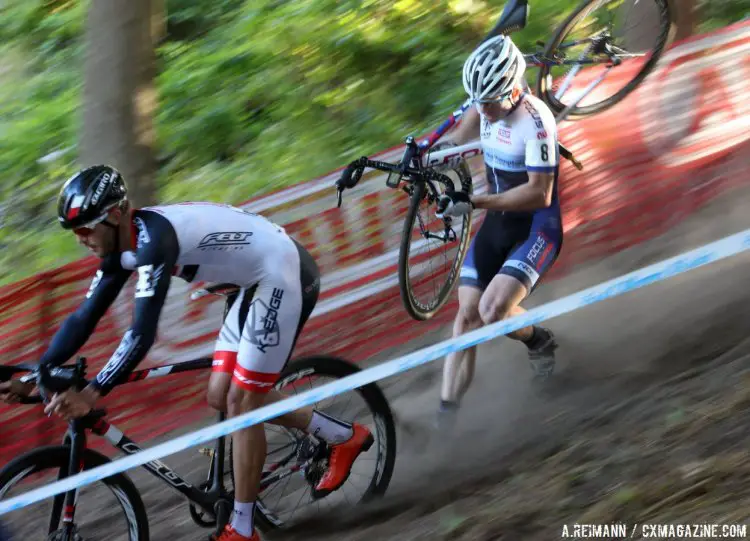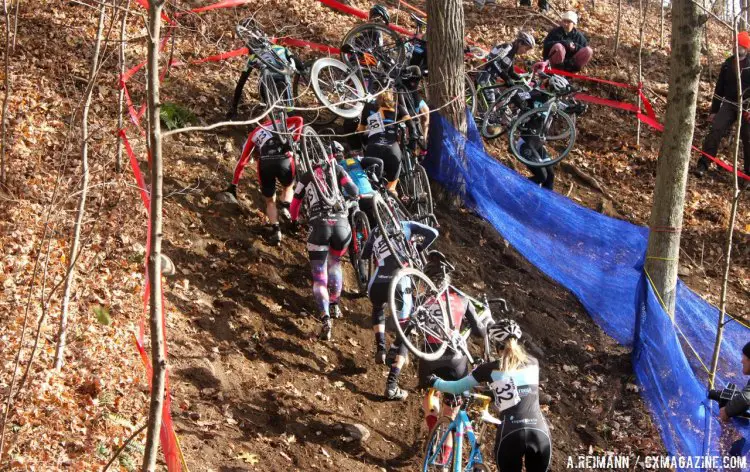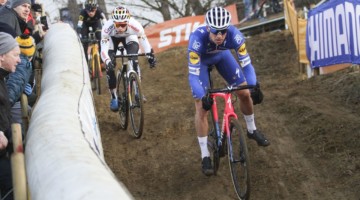
Danny Summerhill and Stephen Hyde descended the Rochester section open only to the elite races. © Andrew Reimann
In recent years, cyclocross courses that include features and sections that are only ridden by the Elite categories are becoming increasingly popular. Should cyclocross courses be the same for everyone? Canadian pro cyclocrosser Michael van den Ham looks at both sides of the issue.
by Michael van den Ham
It goes without saying, but North American cyclocross differs from its European counterpart. Besides our passions for heckling, beer, dollar hand-ups, and single-speed racing, American ’cross has always distinguished itself by offering the identical race-course to every category throughout the day. Whether a first-time ’cross racer, a weekend warrior, or a national champion, a racer experiences the very same terrain and challenges as every rider before and after him or her that day.
It’s one of the endearing things about racing on this side of the pond. Here, cyclocross is a participation-based sport. The professional side of the sport is just that: a single part of a much bigger activity. Unlike Belgium, cyclocross here isn’t about the act of watching. No, it’s about the act of participating alongside the best racers in the country.
But over the past couple of years this notion has been challenged by the addition of pro-only features on ’cross courses. Last season Ellison Park Cyclocross (Rochester, NY), Jingle Cross (Iowa City, IA), and the Cycle-Smart International (Northampton, MA) added technical features later in the day to create new, more technical sections for the Men’s and Women’s Elite races.
The reaction to this change has been mixed. One of the most vocal opponents to adding pro-only features is Tom Stevens of the recently defunct Baystate Cyclocross race. Stevens laments that ’cross courses have become too easy in recent years. Having easy courses, he explains, “really does a disservice to riders. The only way to get better is to ride the tricky stuff.”
Stevens argues that people are making a mistake by assuming that technical courses need to be dangerous courses. “Crashes,” he notes, “happen on straightaways and open roads too. People aren’t getting hurt because a course is technical.” Rather, Stevens argues that courses can be made technical by providing plenty of line choice for different race sections.
If the problem that pro-only features are addressing is that courses are too easy, Stevens thinks the answer isn’t to simply add pro-only features to make a course more difficult. Rather, for Stevens the answer is to make the entire course more difficult for everyone, not just the professionals.
Yet the pro-only features are here, so evidently not everyone agrees with Stevens. When Alec Donahue of Cycle-Smart International and John Meehan of Jingle Cross made the decision to put pro-only features in their races, they did so because they felt it was the best way to cater to their ‘cross-racers’ wide-range of abilities. The remedy Donahue and Meehan chose was not to make courses harder for everyone, like Stevens advocates, but to add in a few pro-only sections. “To have the exact same course from the beginners to the Pro’s is a mistake,” Meehan explains. “One thing the Pro’s say about courses in the US is that they are too easy. Period.”
Both Meehan and Donahue agree that courses should be testing the limits of elite riders. But they found that doing so —while also catering to the concerns of a much larger participation-based group — proved to be impossible on courses that remained static throughout the day.
“We have some many people in the sport now, we have so many newer riders,” Donahue explains. He goes on to recall one experience he had where one of the elite riders thanked him for not making his wife, who was new to cyclocross, ride down a particularly steep bank. “We want to encourage turnout, it’s a friendly environment for new riders. It’s shouldn’t be super intimidating.”
This fear of scaring of new riders is coupled with a more serious fear of seeing those new riders get hurt on sections that are beyond their skill level. Meehan explains that, “We take great pains to make sure the beginner and juniors’ courses are fun and challenging … but not dangerous.”
People need to be protected from themselves Donahue adds. “We like all of our racers and don’t want to see any of them get hurt.” While he agrees that it isn’t fair to assume that every elite racer is more technically skilled than every other racer, it is fair to assume that they have more experience than their Cat 5 counterparts.
On top of that, Meehan and Donahue have used pro-only sections to balance concerns about course safety and course integrity with the need to create more challenging courses for professionals.
When you go to Europe, Meehan notes, the amateurs and professional race on different courses. Instead of having thousands of people ride over the same features, they only a have a hundred or so. Not every part of every course can stand up to this abuse. Over the course of a race, the impact of a thousand racers can degrade a section for racers later in the day or even later in the year. Europeans “don’t have to worry about course integrity like we do,” Meehan explains. Pro-only sections, Meehan believes, can minimize the impact of cyclists on these areas while still using the best natural features that a park has to offer.

The elite races included a few technical sections that forced many to run at Cycle-Smart. © Andrew Reimann
However, while Meehan believes that all races should have pro-only sections, they can prove to be too expensive for smaller events. “Putting in pro-only sections isn’t as straightforward as you’d think. It’s expensive both in time and material to move the course around,” Meehan notes, “I think it’s important to do, but I’m not sure it’s technically or financially feasible for everybody to do it.”
In a respect, Meehan, Donahue, and Stevens see two sides of the same coin. All three agree that ’cross courses have become too easy in recent years, but each has a slightly different way of correcting what they see to be the problem. While Stevens believes that courses should simply become more difficult in general — like they were when he started racing — Meehan and Donahue believe that the addition of pro-only sections is much more well suited to the growing and often inexperienced people participating in their races.
So, should courses add pro-only sections to make them more challenging for the Elites? Or should all courses simply be made more technical? As just a few of the different opinions you’ve seen here demonstrate, the jury is still out. While big cyclocross races like Jingle Cross, Cycle-Smart International, and Ellison Park Cyclocross continue to add pro-only sections, don’t be surprised if your local race, for better or worse, can’t come up with the time, money, or volunteer power to follow suit.




























